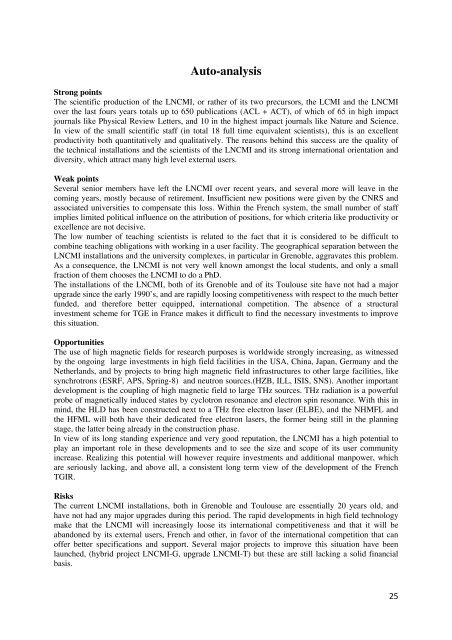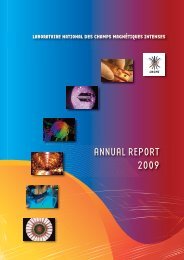Laboratoire National des Champs Magnétiques Pulsés CNRS – INSA
Laboratoire National des Champs Magnétiques Pulsés CNRS – INSA
Laboratoire National des Champs Magnétiques Pulsés CNRS – INSA
You also want an ePaper? Increase the reach of your titles
YUMPU automatically turns print PDFs into web optimized ePapers that Google loves.
Auto-analysis<br />
Strong points<br />
The scientific production of the LNCMI, or rather of its two precursors, the LCMI and the LNCMI<br />
over the last fours years totals up to 650 publications (ACL + ACT), of which of 65 in high impact<br />
journals like Physical Review Letters, and 10 in the highest impact journals like Nature and Science.<br />
In view of the small scientific staff (in total 18 full time equivalent scientists), this is an excellent<br />
productivity both quantitatively and qualitatively. The reasons behind this success are the quality of<br />
the technical installations and the scientists of the LNCMI and its strong international orientation and<br />
diversity, which attract many high level external users.<br />
Weak points<br />
Several senior members have left the LNCMI over recent years, and several more will leave in the<br />
coming years, mostly because of retirement. Insufficient new positions were given by the <strong>CNRS</strong> and<br />
associated universities to compensate this loss. Within the French system, the small number of staff<br />
implies limited political influence on the attribution of positions, for which criteria like productivity or<br />
excellence are not decisive.<br />
The low number of teaching scientists is related to the fact that it is considered to be difficult to<br />
combine teaching obligations with working in a user facility. The geographical separation between the<br />
LNCMI installations and the university complexes, in particular in Grenoble, aggravates this problem.<br />
As a consequence, the LNCMI is not very well known amongst the local students, and only a small<br />
fraction of them chooses the LNCMI to do a PhD.<br />
The installations of the LNCMI, both of its Grenoble and of its Toulouse site have not had a major<br />
upgrade since the early 1990’s, and are rapidly loosing competitiveness with respect to the much better<br />
funded, and therefore better equipped, international competition. The absence of a structural<br />
investment scheme for TGE in France makes it difficult to find the necessary investments to improve<br />
this situation.<br />
Opportunities<br />
The use of high magnetic fields for research purposes is worldwide strongly increasing, as witnessed<br />
by the ongoing large investments in high field facilities in the USA, China, Japan, Germany and the<br />
Netherlands, and by projects to bring high magnetic field infrastructures to other large facilities, like<br />
synchrotrons (ESRF, APS, Spring-8) and neutron sources.(HZB, ILL, ISIS, SNS). Another important<br />
development is the coupling of high magnetic field to large THz sources. THz radiation is a powerful<br />
probe of magnetically induced states by cyclotron resonance and electron spin resonance. With this in<br />
mind, the HLD has been constructed next to a THz free electron laser (ELBE), and the NHMFL and<br />
the HFML will both have their dedicated free electron lasers, the former being still in the planning<br />
stage, the latter being already in the construction phase.<br />
In view of its long standing experience and very good reputation, the LNCMI has a high potential to<br />
play an important role in these developments and to see the size and scope of its user community<br />
increase. Realizing this potential will however require investments and additional manpower, which<br />
are seriously lacking, and above all, a consistent long term view of the development of the French<br />
TGIR.<br />
Risks<br />
The current LNCMI installations, both in Grenoble and Toulouse are essentially 20 years old, and<br />
have not had any major upgra<strong>des</strong> during this period. The rapid developments in high field technology<br />
make that the LNCMI will increasingly loose its international competitiveness and that it will be<br />
abandoned by its external users, French and other, in favor of the international competition that can<br />
offer better specifications and support. Several major projects to improve this situation have been<br />
launched, (hybrid project LNCMI-G, upgrade LNCMI-T) but these are still lacking a solid financial<br />
basis.<br />
25







